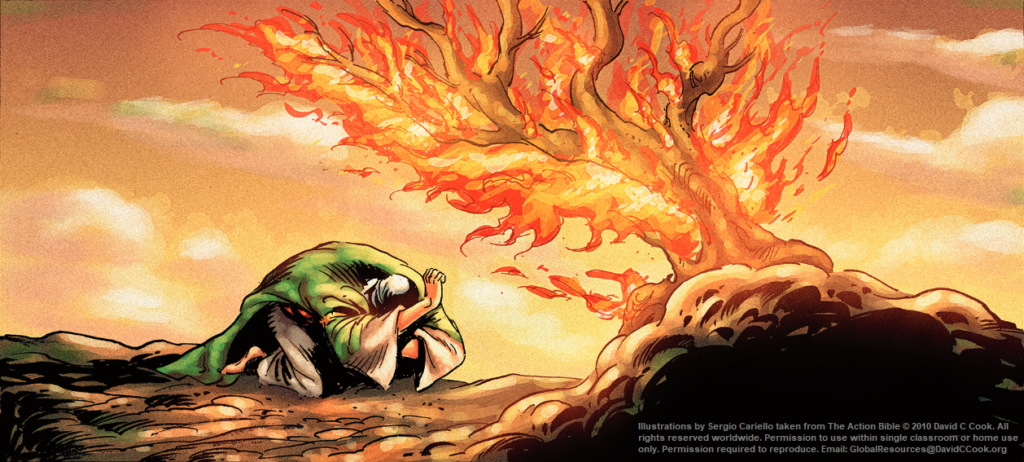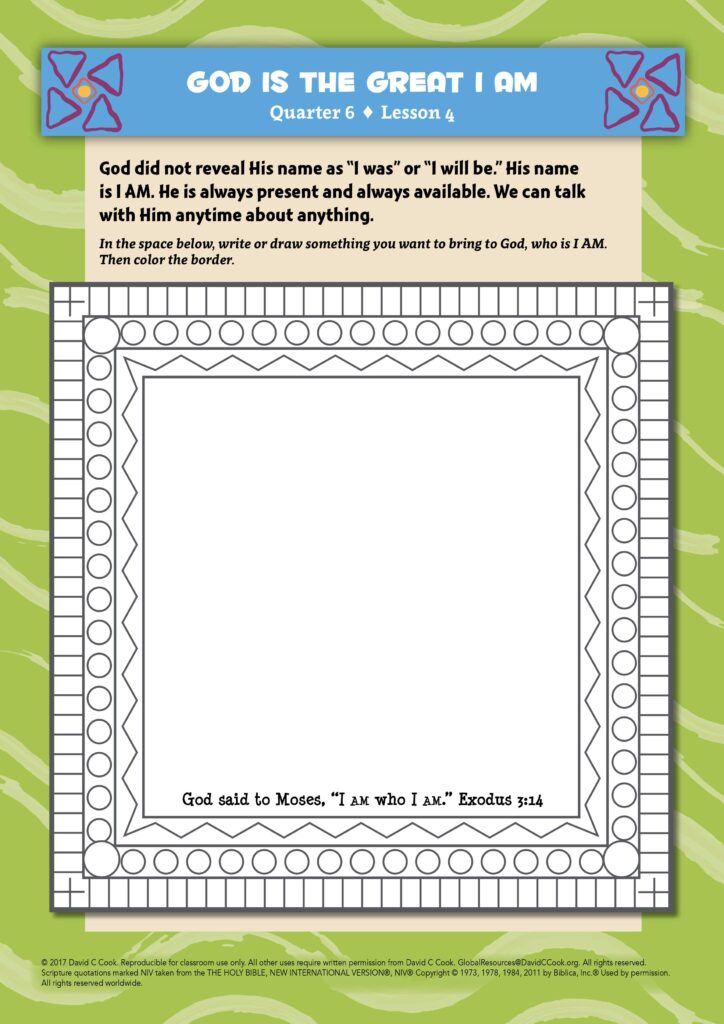During the lesson, the information for you to know is written in regular type, and what we suggest speaking or reading aloud to children is in bold. All resources for this lesson, including the Teacher Guide, Student Page, Family Connection Card, and other resources can be downloaded in a ZIP file by clicking on the following link:
In some lessons you will find "resource articles." These are articles written by experts from around the world to help equip you for your work with children and adolescents. Share them with parents or guardians if you consider it appropriate.
Then the Lord came down in the cloud and stood there with him and proclaimed his name, the Lord. And he passed in front of Moses, proclaiming, “The Lord, the Lord, the compassionate and gracious God, slow to anger, abounding in love and faithfulness.”
Exodus 34:5–6
When life feels overwhelming with worry, fear, pain, or other difficulties, where do we turn? It can be easy to feel that we must bear the weight of this life alone. But God who is I am is present with us. He is compassionate, slow to anger, and full of love for us in all our weaknesses and difficulties.
Think about this for a moment: God, who is Creator of all, who has all power, is all-knowing and
cares for us. Pause, take off your shoes, and bow in His presence as Moses did. Spend a moment worshipping this great, great God who is with us. Pray that the children will begin to know God who
is present with them.
Share with families that today children will learn that God is “I Am”—He is present and cares for each of us. They can ask their children how they feel knowing that God cares for them.
Teacher Tip: If possible, email or text the Family Connection Card to the families of your students.
Welcome your children to class today. Let them know that today they will learn the name for God that is the one used most often in the Bible. It is used over 6,000 times.
Begin class by telling the children that they will play a guessing game. Think of different animals, such as a sheep, goat, chicken, camel, tiger, elephant, snake, water buffalo, cat, dog, duck, crocodile, tortoise, mongoose, wolf, fox, jackal, or leopard. Whisper an animal to each child. The goal of the game is to ask others yes and no questions to try to figure out the animal each person has.
This game is called “Who am I?” I whispered an animal to each of you. You will go around and ask each other yes and no questions and try to guess each other’s animals. Some good questions might be “Does your animal have fur?” “Does your animal live in the water?” “Does your animal eat grass?” “Is your animal wild?” When you guess, try to do it quietly so you do not give away that animal name to others. See how many animals you can guess before I call time.
After about 7–8 minutes, congratulate the children on great guessing! Ask them to sit down.
Today we gathered clues by asking questions about our animals. Some of our questions asked about what the animal looked like. Some questions asked about how the animal acted. Other questions asked about the character or nature of the animal.
All this month we are learning names of God. These names help us know what God is like and understand His character better. Today’s name is the one that is used most often in the Bible.
First let me give you some background for today’s story. For many years, God’s people had been forced to live as slaves in the land of Egypt. They cried out to God for someone to save them from their pain and suffering. God did not forget His people. He saw their suffering, and He had a plan to send someone to free them.
It was a difficult time in Egypt for God’s people. The king of Egypt, known as Pharaoh, was afraid that the Israelite slaves were becoming too numerous. If a war broke out, the Israelites might join Egypt’s enemies and overthrow the Egyptian government. So Pharaoh ordered their baby boys to be killed. Moses was born the son of poor Israelite slaves in Egypt. To save him, Moses’ mother set him in a basket in the river. He was rescued by Pharaoh’s daughter.
Moses grew up in the palace as a prince of Egypt. One day when he was 40 years old, he saw an Egyptian guard beating an Israelite slave. Moses struck the guard and killed him. When this was discovered, Moses ran away into the wilderness. If he was caught, he would be put to death for what he had done.
For the next 40 years, Moses lived in the desert working as a shepherd. That is where Moses was when our Bible story begins. Listen now to this amazing story.
Use lots of emotion in your voice to help bring this story to life.
One day, Moses was out in the desert taking care of the sheep. He was near Mount Horeb, which is called “the mountain of God,” when suddenly he saw something very unusual. A bush was on fire, but it did not burn up! So he thought, “I want to see this strange sight. I will go see why this bush is on fire but does not burn up.”
Suddenly God called to Moses from inside the bush. “Moses! Moses!” God said.
“Here I am!” Moses said.
“That is close enough!” said God. “Take off your sandals. You are standing on holy ground.” Then God reminded Moses of who He is. “I am the God of your father. I am the God of Abraham. I am the God of Isaac. And I am the God of Jacob. I have heard my people crying out. I am concerned for their suffering,” God said.
Optional: If possible, share the image from The Action Bible.

When Moses heard God’s voice, he turned his face away because he was afraid to look at God. But he became even more afraid when God said He was sending Moses to tell Pharaoh to let God’s people go.
“Who am I?” Moses cried to God. “Who am I to go to Pharaoh and save Your people from Egypt?”
God told Moses, “I will be with you. Go, bring My people out of Egypt and together worship Me on this mountain.”
“But God,” Moses said, “what if I go to the Israelites and say, ‘The God of your fathers has sent me to you,’ and they ask me, ‘What is His name?’ What should I tell them?”
God answered Moses, “I Am Who I Am. Tell them that I Am sent you.” Then God said, “Say to the Israelites, ‘The Lord, the God of your fathers, has sent me to you. This is My name forever, the name you shall call me from generation to generation.’”
The Hebrew word for this special name is Yahweh. Yahweh means “He is.” That name is closely related to “I am.” When God refers to Himself, He says, “I Am.” When His people refer to Him, they say, “He is.”
Then God showed Moses some of the wonders He would do through Moses. Moses was still afraid, but he decided to believe in the great I Am. Moses went back to Egypt and did all that God told him to do. He led the people out as God had said.
God did not reveal His name as “I was.” His name is I am. He is always present and always available. We can approach Him anytime about anything. This name more than any other reveals God as One who has always been and always will be. He is the God who hears our cries and cares about our suffering too!
Moses realized that the God who is I Am deserved to be worshipped and obeyed. He chose to do what God asked him to do even though he was still afraid.
If you are using the Memory Verse Poster, show it to the students.
“The Lord, the Lord, the compassionate and gracious God, slow to anger, abounding in love and faithfulness.”
Exodus 34:5–6

When Moses stood before God, he took off his shoes. People in many cultures take off their shoes as a sign of respect.
God told Moses to take off his shoes because he was in the presence of God. Moses could not treat God the same way he would anyone else. Being in God’s presence was an uncommon thing. Moses took off his shoes to acknowledge God’s greatness and show Him respect.
Encourage your children to take off their shoes if they are wearing them.
We invite God into this space with us. We have taken off our shoes to show that we are in God’s presence. We want to honour and respect Him.
In the Bible, we can read some other names for the One True God. Listen to them and to what they mean. Think about which one means the most to you.
I will read the names again slowly. When you hear the name that means the most to you, stand up. Gather together with the others who also stood up for that name.
After you have read through the names again and the children have gathered into groups, tell them to pray for each other to know God by that name this week. For example, the group who chose The Lord My Peace could pray for God to give them peace when they are lonely or when they are facing a difficult test at school. Each child can pray for another in the group to know God as the Lord of peace.
Optional: If you are using the Student Pages, allow the children to draw on their pages the things they want to bring to God. Then they can colour the other names for God on the page.

Close today by praying this blessing based on Exodus 34:6–7. Invite the children to hold their hands palms up to receive the blessing from God.
Blessing: May you know God who is the I am—the One who is present with you. He is tender and kind with you. He is slow to anger. May He fill your heart with His unending love.
Lead the children in singing this quarter’s song, if possible.
Life on Life ©2020 David C Cook. Reproducible for home or classroom use only. All other uses require written permission from David C Cook [email protected]. All rights reserved.